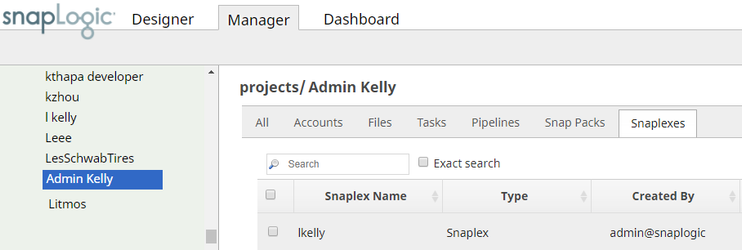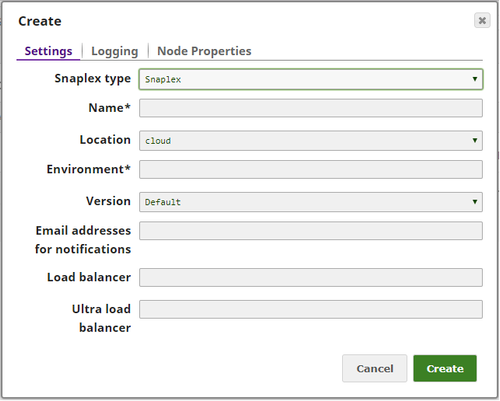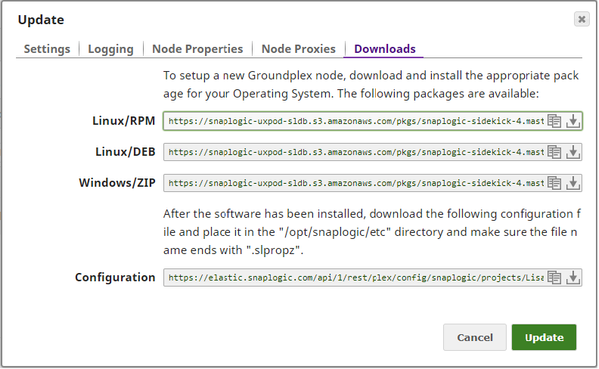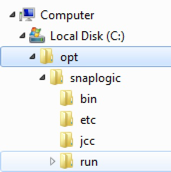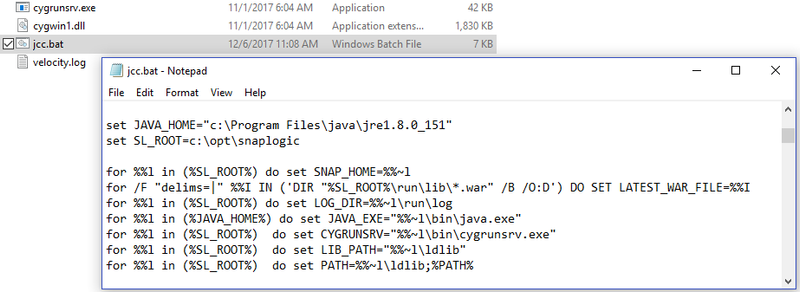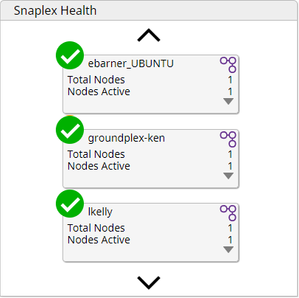In this article
Anti-virus Requirements
We recommend you disable any anti-virus or firewall software (including Windows firewall) installed on the Snaplex node. If you cannot disable the software, then ensure that the Snaplex process is not scanned by the anti-virus. The specific action depends on the antivirus software type and scanning rules enabled. The following are the guidelines:
- Disable the network firewall functionality for the following ports: 8081, 8084, 8089, and 8090. See the Required Ports section below for more information about workarounds for other applications using the required ports.
- Disable filesystem scanning for the
c:\opt\snaplogicfolder. - Disable process-level scanning for the SnapLogic service.
Required Ports
| Function | Port | Protocol |
|---|---|---|
| JCC node's HTTPS | 8081 | TCP |
| FeedMaster node's HTTPS | 8084 | TCP |
| FeedMaster node's broker | 8089 | TCP |
If another application already uses one of the JCC ports used by SnapLogic, the JCC nodes do not complete a full start cycle. The workaround is to override the default port by assigning the following entries in the global.properties file to ports that are available:
- For HTTP port: jcc.jetty_port = 8x89
For HTTPS port: jcc.cc_secure_port = 8x81
Java Development Kit (JDK)
You must install the Java Development Kit (JDK) before installing your on-premise Snaplex. The SnapLogic platform supports Java 11. We recommend you use the latest patch version available of Java 11 for your Windows environment. To update your Snaplex to the Java 11, see Upgrading Your Groundplex to Java 11.
JDK11 Distribution
Only AdoptOpenJDK 11 (Adoptium) is certified by SnapLogic. Since no other JDK 11 distribution is currently certified by SnapLogic, we recommend that you only use Adoptium's JDK when upgrading to Java 11.
File Name Length
File names generated by SnapLogic for suggest data can be longer than 260 characters long. We recommended that you configure the Snaplex node to allow longer file paths. See Maximum Path Length Limitation - Win32 apps for details.
Installing the Snaplex
If the Snaplex is already installed on the machine, the old installation needs to be stopped before the installation can be done at a new location.
To stop the old installation, run bin\jcc.bat stop. If the Snaplex was installed as a service, the service needs to be removed by running the bin\jcc.bat remove_service.
- As an Org admin, log into SnapLogic Manager.
- Under Project Spaces on the left, locate the project where you want to create your Groundplex (or the global shared project), then select the Snaplexes tab on the right.
- Click the Create + button and complete the Create Snaplex dialog (later known as the Update Snaplex dialog).
- Once completed, the dialog reopens to the Downloads panel.
- Download the Windows ZIP file and the configuration file onto the Windows machine where you want the Groundplex installed.
- Create the directory
\opton your server in the root of the C: drive. - Unzip the zip file to
c:\opt. This will create a directoryc:\opt\snaplogicand a directory structure as follows: Check your Windows environment to see if you have a version 11 of Java.
Version of Java
Make sure the version of Java that you are installing matches the type (32-bit or 64-bit) of Windows machine.
Do this by executing the commandjava -versionin a command window.- If the version of Java is less than JDK 11, download the Windows JDK and install the JDK at
c:\opt\java. - If JRE 11 is already available on the machine, the existing installation can be used. Use Notepad to edit the file
c:\opt\Snaplogic\bin\jcc.batand change the entry for the JAVA_HOME environment variable to the location of the existing installation, putting double quotes around the value. - If the host machine is configured for JDK auto-update, then each time a JDK update occurs, the older JRE installation is deleted by default. As a result, the Snaplex fails to start after the JDK update. To avoid this issue, use the static installation feature of the JDK installer.
To do a static install:- Add the
STATIC=1option when running the JDK installer from the command line or from the Run dialog. - When the JRE auto-update occurs, uncheck the uninstall option for older JDK installations. This prevents the older installation from being removed.
- Add the
- If the version of Java is less than JDK 11, download the Windows JDK and install the JDK at
- After the software has been installed, place the downloaded configuration file in the \
opt\snaplogic\etcdirectory and make sure the file name ends with.slpropz. - From the command prompt, change to the
\opt\snaplogic\bindirectory. You may start the node by running the command:jcc.bat start
Alternatively, to install the Snaplex as a Windows service, run the following command as an administrator:jcc.bat install_service
Then, go to the Windows Control Panel services, to view the entry for the SnapLogic Snaplex, and start the service from Tools in the Services window. To establish if the process started, run the command:
jcc.bat status. The state should beRunning.To verify the Snaplex has started, visit https://elastic.snaplogic.com/sl/dashboard.html#Health
The newly installed node should show up in the list of nodes for the Snaplex.
Upgrading on Windows
Updating Cygwin Binaries
When running the Windows-based Snaplex as a service, performing a service restart causes the Monitor process to start with the old binaries files.
When upgrading your Snaplex to the 4.29 release (May 2022), you need to reinstall the Snaplex using the 4.29 installer zip file for Windows. Upgrading through Manager will only upgrade the war file, but not the binaries.
To update the service to use the latest binaries, you can choose from one of the two following options:
Option 1: Perform a Complete Reinstallation
Stop the Windows-based Snaplex service.
Remove using
bin\jcc.bat remove_service.Back up the configuration files from \
etcfolder.Custom Configuration Properties
If you have a customized node configuration, make sure to back up the global.properties file to retain the customized node configuration after the upgrade.
Remove
C:\opt\snaplogic.Reinstall the Windows-based Snaplex using the 4.29 zip file.
Option 2: Install the Latest Cygwin Binaries Only
- Unzip the 4.29 zip into a different location.
- Copy
bin\cygwin1.dllandbin\cygrunsrv.exefrom the new zip to the existing installation location. - Update and restart the service using
bin\jcc.bat update_service.
Disabling Automatic Update
By default the JCC node will automatically update itself. To disable this, apply the following setting in c:\opt\snaplogic\etc\global.properties:
jcc.enable_auto_download = False
Troubleshooting Installation
- Are you starting the JCC node as an administrator?
- Is the c
:\opt\snaplogic\run\logfolder full? If it is full, delete the logs and try restarting again. - Is JAVA_HOME set correctly?
Temporary files created by the Snaplex service are stored under the user account that started the JCC process. In some cases, if the user account used to start the Snaplex is changed or if the Snaplex was previously started as an application and now is being started as a service, then you might encounter startup errors because of the user account being different. In such cases, deleting the following folders can help fix the issue:
run\logrun\fsrun\broker
In a Snaplex installation on a Windows machine, you need to install the JRE and configure the JRE location in the jcc.bat property. While a Snaplex auto upgrade updates the SnapLogic binaries in the installed Snaplex, the JRE version is not automatically updated. You must manage the JRE version in your self-managed Snaplex.
We recommend installing the latest JRE 11 version available at https://adoptium.net/temurin/releases/?version=11.
If you are running with 11.0.10 onwards, endpoint connections to TLS 1.0 and 1.1 are disabled by default. We recommend that you update the endpoint to support TLS 1.2 or higher, for security.
Uninstall the SnapLogic RPM from your environment
To uninstall the SnapLogic Windows-based package from your environment:
Stop the Snaplex service before uninstalling or installing the Snaplex elsewhere by using the following command.
runbin\jcc.bat stop.If Snaplex is installed as a service, the service needs to be removed by running the command.
bin\jcc.bat remove_service.Clean up the directory
\opton your server in the root of the C: drive.
If you are reinstalling a JCC node, stop the Snaplex service that is already installed.
Older Versions of JRE and TLS
JRE versions prior to 11.0.8 have issues connecting to TLS 1.3 endpoints. We recommend using a newer JRE version.
Renabling Support for Older Versions
If updating the TLS endpoint is not possible, then the Snaplex JRE can be updated to re-enable support for older TLS versions by doing these steps:
Open the jre/conf/security/java.security file in the JRE installation folder that you configured during installation.
Change the jdk.tls.disabledAlgorithms configuration property by removing TLSv1, TLSv1.1.
Restart the Snaplex to re-enable support for TLS 1.0 and 1.1.
